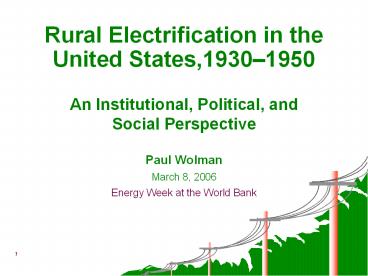March 8, 2006 - PowerPoint PPT Presentation
1 / 18
Title:
March 8, 2006
Description:
United States,1930 1950. An Institutional, Political, and. Social Perspective. Paul Wolman ... June 1, 1940 Uncle Lark wired house. August 8, 1940 Got electricity ... – PowerPoint PPT presentation
Number of Views:25
Avg rating:3.0/5.0
Title: March 8, 2006
1
Rural Electrification in the United
States,19301950An Institutional, Political,
and Social Perspective Paul Wolman
- March 8, 2006
- Energy Week at the World Bank
2
The United States as a Developing Country
- Agriculture, the U.S. Rural South, 1930s
Left Boy with hoe. North Carolina, 1936.
Right Tenant tobacco and corn farmer, Hwy. 144,
Person County, NC, July 1939. Nitrate negatives,
Farm Security Administration. Photos Dorothea
Lange.
3
The United States as a Developing Country
- Conditions in the U.S. Rural South, 1930s
- Low farm prices, agricultural depression,
1920s - Large population movements to cities and West
- High levels of debt and farm-mortgage
foreclosure - High rates of sharecropping and tenancy
- Poor health, nutrition, sanitation (especially
for women and children) - Low population densities
- Rural electrification less than 15.
4
The United States as a Developing Country
- The U.S. Electrical Industry, 1930
- Nonfarm electrification 84
- Large utility holding companies controlled 75 or
more of generating capacity - Multiple regional grid systems
- Utilities grew out of jurisdictions of
metropolitan, county, and state authority - Lack of effective national regulation
- Little interest in RE because of lowdensity
(U.S. trailed most of Europe)
5
Origins of the RE Program
- Progressive initiatives
- early 1900s (e.g., Country Life Movement T.
Roosevelt, L. H. Bailey, G. Pinchot) - (Republican) progressives
- engineering and political ideas, 1920s (e.g., G.
Pinchot and M. Cooke, Giant Power) - (Democratic) New Deal,1930s
- (e.g., F.D. Roosevelt, TVA, M. Cooke, D.
Lilienthal)
6
Origins of the RE Program
- U.S. Rural Electrification Administration
- REA Founded FDR executive action,1935
- Rural Electrification Act of 1936
- Utilities would not participate in distribution
- Utilities did participate in generation and
wholesale electricity transmission
7
Origins of the RE Program
- Cooperatives became focus
- Rochdale principles
- Egalitarian area coverage versus
cherry-picking by utilities
8
Early Difficulties
- RE about 12 percent in the rural U.S. in 1935
- Existing RE not really rural
- primarily near higher-demand towns or large-scale
farms - Utilities sought to subvert RE (e.g., spite
lines) - Opposition from some state commissions
- Opposition from academic and agricultural
extension
9
REA and Co-ops Respond
- Farmers had long resented utilities
- REA mobilized technical and support and
innovation, cut costs - REA construction costs 1/3 to 1/2 of utilities
- Electricity rates 1/3 to 1/2 of utilities
- Perceived equity of REA program and co-ops
solidified popular support
10
Financial Viability
- Distribution loans at 3
- Early lending heaviest in South and Midwest
- Nonprofit co-ops had to use all revenue and
operating income to amortize debt to REA/RFC - Term for distribution loans, 25 years (extendable
to 30). No formal subsidies - Lending for household wiring and appliances,
terms up to 66 of appliances lifespan, capped
at 5 years - Wholesale electricity pricing constrained by TVA
and federal power sales_at_ 2 to 5/kWh
11
A Typical Rural Electric Cooperative
- Consumer membership 1,000
- Total distribution line 425 miles
- Average monthly bill (100 kWh) 5 to 6
- Minimum consumption averaging 60 kWh/mo per
customer (REA/RFC loan required) - Lifeline rates for poor consumers
- Long-term financing for wiring (Arkansas Plan)
and appliances(EHFA)
12
Electrified Tenant Farmhouse Georgia, 1941
13
Household Diary, Oklahoma 193950
- July 27, 1939signed for cooperative membership
- June 1, 1940Uncle Lark wired house
- August 8, 1940Got electricity
- August 26, 1940Bought a washer
- October 29, 1940Bought a radio
- January 6, 1941Wired milk barn
- July 25, 1941Bought iron
- September 19, 1941Bought refrigerator
- January 21, 1942Wired Dutton Church
- December 3, 1942Bought mixer, radio
14
Consumer Acceptance
The REA sponsored fairs and campaigns aimed at
promoting connections and demand
Co-op members enjoying the benefits of
electrificationlistening to the radio
15
Impact of the RE Program
- From zero consumers to
- 3.4 million consumer/members served
- 1.1 million miles of distribution line built at
costs 1/2 those of utilities - 1,007 self-sustaining coops (vs. 2 in 1935)
- 147kWh/month average rural household consumption
16
Household Electrification
17
Key Success Factors
- Technical assistance from REA key to low line
construction costs and power rates - Security and stability of funding in initial
years - Pace Act 1944 extended REAs term indefinitely
- EHFA and Arkansas plans funded acquisition of
appliances - Egalitarian area coverage united rural
residents around co-ops - Co-ops simple self-governance, bill collection
- Suprapartisan political support Progressives,
New Deal Democrats, and even utilities (in
generation)
18
Conclusions
- USRE a product of Great Depression but also of
more general consensus on rural development - However, enfranchisement of African Americans and
Native Americans lagged behind that of whites - RE programs important to social stabilization
- Shows value of mixed / joint venture with public
funding, regulation, and popular private
nonprofit ownership - Co-ops still operating effectively
- Electrification is not an implacable force
moving through history but a social process that
varies from one time period to another, from one
culture to another - David Nye, Electrifying America































